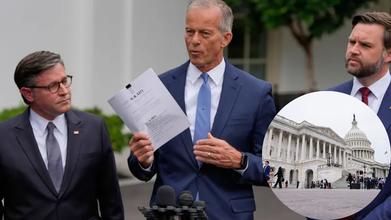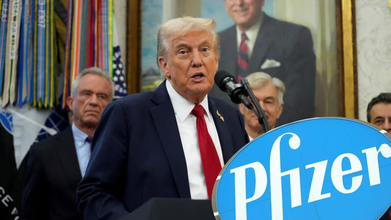- Health Conditions A-Z
- Health & Wellness
- Nutrition
- Fitness
- Health News
- Ayurveda
- Videos
- Medicine A-Z
- Parenting
- Web Stories
International Day Of Older Persons 2025: Theme, Significance, and Origin

Credits: Canva
Every year on October 1, International Day of Older Persons is observed so as to raise awareness about the challenges and opportunities of ageing. The World Health Organization (WHO) notes that it is a day for honoring the contribution of older persons to society and also highlighting the importance of their dignity, independence, and inclusion.
International Day of Older Persons 2025 Theme
This year's theme advocates for healthy and inclusive aging. The United Nations (UN) Secretary-General Antonio Guterres says, "This year's theme reminds us, older persons are powerful agents of change. Their voices must be heard in shaping policies, ending age discrimination, and building inclusive societies."
UN notes that this year's theme is: Older Persons Driving Local and Global Action: Out Aspirations, Our Well Being and Our Rights.
Importance And Significance of International Day Of Older Persons
WHO notes that by 2100, the number of people aged 65 and over would reach 2.4 billion, and the fastest growing segment will be those aged 80 and older. Much of the work at the WHO Kobe Centre aims to accelerate progress toward universal health coverage (UHC) in the context of population ageing to improve the accessibility, affordability and acceptability of health services including long-term care (LTC) for older people.
Over the past year, new research was undertaken to examine unmet health and social care needs among older adults (generally above 60 years) across five of WHO’s regions. The aim was to ensure that this population is not excluded from global progress towards universal health coverage (UHC).
For the first time, policymakers have access to region-specific evidence highlighting the gaps and opportunities in care, enabling them to address barriers that lead to unmet needs. Strengthening health information systems in this way is considered vital for inclusive planning and for improving health outcomes and wellbeing among older people.
How health services are financed also plays a critical role in ensuring coverage, quality, financial protection, and overall outcomes for older populations.
Read: From Infants To Elderly: There Is No Age To Get Your Heart Checked, According To Doctors
Origin of International Day For Older Persons
It was on December 14, 1990, when the UN General Assembly designated October 1 as the International Day for Older Persons, under the resolution 45/106. This was preceded by initiatives such as the Vienna International Plan of Action on Ageing, which was adopted by the 1982 World Assembly on Ageing and endorsed later that year by the UN General Assembly.
In 1991, the General Assembly adopted the United Nations Principles for Older Persons (resolution 46/91). In 2002, the Second World Assembly on Ageing adopted the Madrid International Plan of Action on Ageing, to respond to the opportunities and challenges of population ageing in the 21st century and to promote the development of a society for all ages.
The number of older people (defined as those aged 65 years or older) tripled from around 260 million in 1980 to 761 million in 2021. Between 2021 and 2050, the global share of the older population is projected to increase from less than 10% to around 17%. Rapid growth in the number of people reaching older ages underscores the significance of promoting health, preventing, and treating illnesses throughout the entire course of life.
US Government Shutdown: What Does It Mean For Health Services?

Credits: AP
The US government shuts down at midnight confirmed Associated Press. The Vice President JD Vance said, "I think we're headed to a shutdown because the Democrats won't do the right thing," after a meeting where Congressional Democrats refused to give Republicans the votes they needed to pass a short-term funding agreement. The Democrats have demanded overhauls to Medicaid cuts and extensions to health care tax credits, something Republicans wish to stay out of.
House Minority Leader Hakeem Jeffries said that Republicans are "divorced from reality". He said, "They just wanted to kick the health care problem down the road."
What Does US Government Shutdown Mean For Health Services?
During a shutdown, only 59% of employees would be working at the Department of Health and Human Services. The rest are to be furloughed, meaning to be discharged from their job.
This means, out of the 47,257 employees who would be kept during the shutdown, only 35,000 would be continued to paid, while 12,000 would work without pay. Around 32,460 Health and Human Services (HHS) employees will be discharged from their work.
For the Centers for Disease Control and Prevention (CDC), only 36% of employees would work, with 15% without pay, also reported by ABC News. At the Food and Drug Administration (FDA), 86% employees would continue to work, with 19% without pay.
What it means for safety guidelines? The FDA's Animal Drugs and Foods Program "would end pre-market safety reviews of novel animal food ingredients for livestock, thus be unable to ensure that the meat, milk, and eggs of livestock are safe for people to eat; activities would be limited to those that address imminent threats to the safety of human life".
The National Institutes of Health would also come down to 24% of employees.
Will Medicare and Medicaid Continue During The US Government Shutdown?
Federal spending's biggest portion which is considered 'mandatory' will remain untouched, including payments by Social Security, Medicare and Medicaid.
While government officials say that payments won't be affected, related services could, however, slow down, including receiving replacement cards and benefit verification services.
This could also threaten around 7 million low-income women and their children who relied on programs like the Women, Infants. and Children (WIC), a US federal program that provides nutritious foods, nutrition education, and referrals to healthcare and social services for low-income pregnant and postpartum women, infants, and children up to the age of 5, who are at nutritional risk.
Ali Hard, who is the policy director for the National WIC Association told ABC News that if a shutdown continues for more than a week, WIC may begin to run out of funds.
Why Is The US Government Shutting Down?
The main crux of it could be the disagreement in the health policies. For the extended funding, which would only be possible through cuts in Medicaid, the Senate voted 55-45 on the measure, which has left Republicans five votes short of 60 vote threshold.
President Donald Trump on this said, "They (Democrats) want to give health care to illegal immigrants, which will destroy health care for everybody else in our country."
Previously it happened during the 2018-2019 shutdown, which lasted for 35 days.
Trump-Pfizer Deal: What Does It Mean For Drug Prices In America?

Credits: Reuters and Pfizer
US pays more than it should for prescription medicines, a view US President Donald Trump has upheld for the longest. Reflecting on the same, Pfizer, an American multinational pharmaceutical company on Tuesday said that it had agreed to cut prices for the drugs it sells to the Medicaid program for low-income Americans and to ensure the US would not pay more for new medicines as compared to other high-income nations. In the view of this, Trump said that he hopes other drugmakers to follow the suit.
The TrumpX Website
A Reuters report note that by early next year, the US government plans to launch a website called TrumpRx. This website will help customers directly buy the drugs from manufacturer. At this moment, nearly all of the existing direct-to-consumer sales platform require patients to buy their medications out-of-pocket.
In this background, the website hopes to bring the cost down.
Price Cuts For Medicaid
Pfizer has announced plans to cut prices for most of its treatments covered by Medicaid, the federal and state health insurance program for low-income individuals and families. While the company shared few details on the timing or scale of discounts, the move comes amid growing scrutiny of drug costs in the U.S.
By law, drugmakers must already provide Medicaid with significant discounts compared to the lowest available market price. Medicaid accounts for roughly 10% of total U.S. prescription drug spending. It remains unclear whether Pfizer’s decision will extend to private insurers or other government programs such as Medicare.
Global Pricing Commitment
Pfizer also said it will introduce new medicines in the U.S. at the same price offered in other high-income countries. Research has consistently shown that American patients pay significantly more for brand-name drugs, over three times higher than consumers in other wealthy nations.
According to a Reuters report, average launch prices of new drugs in the U.S. more than doubled in 2022, reaching $370,000 compared to $180,000 the year before. Much of this increase reflects the surge in therapies for rare diseases, which typically command higher prices. Some companies have already moved toward price alignment, Bristol Myers, for instance, announced plans to launch its schizophrenia drug Cobenfy in Britain at the same price as in the U.S.
Still, uncertainty remains over whether listed prices will represent the final cost, as drugmakers often negotiate confidential rebates with governments and insurers.
Pressure on Global Markets
The Trump administration, which has supported these pricing shifts, has also signaled that it wants other countries to pay more for branded medications, a proposal that has drawn resistance from international governments. The U.S. has argued that higher overseas prices would support research and development, though global health officials remain cautious.
Trade Tariffs and U.S. Manufacturing
In a bid to avoid looming tariffs, Pfizer pledged to bring 100% of the value of its pharmaceutical imports onshore by building U.S. manufacturing capacity. Under the plan, the company will receive a three-year exemption from new tariffs targeting patented and branded drugs. Former President Donald Trump has warned that without such measures, branded pharmaceutical imports could face tariffs of up to 100% beginning October 1.
Madonna Reveals Sepsis Ordeal, Says She Was Unconscious For Four Days- All You Need To Know About The Infection

Credits: Canva
Madonna has opened up about her frightening 2023 health scare while she was on tour. In a recent conversation with Jay Shetty on his On Purpose podcast, aired Monday, Sept. 29, the 67-year-old pop icon revealed how she battled sepsis, spending four days unconscious in the hospital after what doctors called a “serious bacterial infection.” She also shared how her faith and practice of Kabbalah played a role in her recovery.
Madonna’s Sepsis Ordeal
The singer was first hospitalized in June 2023, later telling fans at a Brooklyn show that December that she had been placed in an induced coma for 48 hours. Speaking with Shetty, she recalled how suddenly her condition escalated: “I was rehearsing for my tour, and I got a bacterial infection. One minute I was alive and dancing around, and the next I was in the ICU, waking up after being unconscious for four days.”
Reflecting on the experience, Madonna noted, “There’s no way we’re going to escape suffering. Even if you grow up with wealth and privilege, challenges and pain come to you in different ways.”
What Is Sepsis?
Sepsis occurs when the body has an extreme reaction to an infection. Instead of fighting only the infection, the immune response spirals, damaging healthy tissues and organs. In severe cases, sepsis can progress to septic shock, where blood pressure drops dangerously low and vital organs like the lungs, kidneys, and liver can fail. If untreated, it can be fatal, according to the Mayo Clinic.
Sepsis: Signs and Symptoms
Warning signs of sepsis can include:
- Sudden confusion or altered mental state
- Rapid, shallow breathing
- Unexplained sweating
- Dizziness or lightheadedness
- Chills and shivering
Because these symptoms are often vague and vary from person to person, sepsis can be difficult to recognize, and it may present differently in children compared to adults.
Who Is Most at Risk?
While sepsis can affect anyone with an infection, injury, or underlying illness, certain groups face higher risk. According to the World Health Organization, these include:
- Older adults
- Pregnant or recently pregnant women
- Newborns
- Hospitalized or ICU patients
- People with weakened immune systems, such as those with HIV or cancer
- Individuals with chronic conditions like kidney disease or cirrhosis
Sepsis is a medical emergency, and early treatment is critical to improving survival and recovery. Even healthy individuals can go from feeling fine to critically ill in a matter of hours. Experts stress the importance of recognizing early warning signs and seeking immediate medical attention, as timely intervention can make the difference between life and death.
© 2024 Bennett, Coleman & Company Limited

